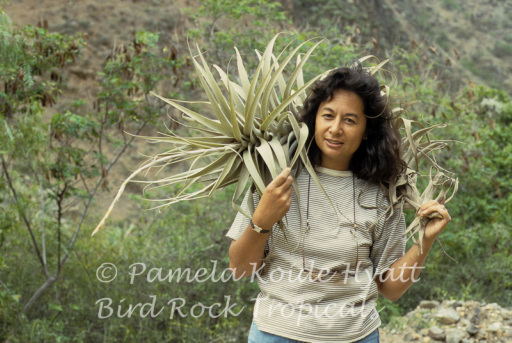 Author with T. latifolia var. major, in the Peruvian Andes.
Author with T. latifolia var. major, in the Peruvian Andes. Tillandsia latifolia is a variable species. New tillandsia collectors sometimes have trouble identifying the differences between the Tillandsia latifolia species. Here is some basic information about the species and how to recognize them.
T. latifolia species are found growing from Equador to southern Peru. They range in size from less than one inch to as much as six feet long. Most T. latifolia will produce offsets on the old bloom spike after blooming, some do not. All species of T. lalifolia pup near the base of the plant or at the base of the inflorescence. All varieties have spikes that are orange to orange-red in color. The bloom spikes can be glossy or lepidote (covered with fine scurf). Currently, the four recognized species are T. latifolia var. latifoila, T. latifolia var. major, T. latifolia var. divaricapta and T. latifolia var. leucophylla. There are several cultivars registered in the BSI Cultivar Registry, but I'll save their discussion for another post.
T. latifolia var. major, (pictured above) sometimes called "var. gigantea" can grow to become a very large specimen. This form has a caulescent (elongated stem) habit, and will twist and bend as it grows to a mature size of four to six feet in length. It will occasionally produce offsets on the old flower spike, but not always. It does produce pups at the base of the plant along the stem.
T. latifolia var. leucophlla, the easiest to identify, is a lithophytic (cliff dwelling) species which has thick semi-succulent leaves covered densely with tiny trichomes (scales) , making the plant appear almost white in color. It is the only variety with a pendent inflorescence. It does not produce offsets on the flower spike, but does at the base of the spike. It is easy to grow, and tolerates a wide temperature range. It has a limited range in Peru.
T. latifolia var. divaricata is primarily an epiphytic (growing on trees) species, found in both Peru and Ecuador. It has an open rosette with narrow, long leaves. Sometimes the leaves are smooth, sometimes they are covered with a scurf (trichomes). The inflorescence extends well above the rosette. It rarely pups on the inflorescence, but does make pups at the base of the plant.
T. latifolia var. latifolia, is found growing with T. purpurea, on the sand dunes in the coastal desert of western Peru. This harsh area is exposed to salty air and long periods without rain. The majority of the year, the coastal zone is immersed in fog. It is interesting to observe these plants in habitat, as they all grow in the direction of the Pacific Ocean, toward the available moisture. They vary in size tremendously, and as you progress north along the coastal zone you will see the size of each colony change. Some will mature at only one inch tall, others at six inches in height. They are caulescent and have thick leaves covered with tiny trichomes. All of these forms produce pups on the inflorescence as well as at the base of the plant. You can separate the pups from the old bloom spike and grow them separately, or leave them attached. The will grow either way.
T. latifolia species are found growing from Equador to southern Peru. They range in size from less than one inch to as much as six feet long. Most T. latifolia will produce offsets on the old bloom spike after blooming, some do not. All species of T. lalifolia pup near the base of the plant or at the base of the inflorescence. All varieties have spikes that are orange to orange-red in color. The bloom spikes can be glossy or lepidote (covered with fine scurf). Currently, the four recognized species are T. latifolia var. latifoila, T. latifolia var. major, T. latifolia var. divaricapta and T. latifolia var. leucophylla. There are several cultivars registered in the BSI Cultivar Registry, but I'll save their discussion for another post.
T. latifolia var. major, (pictured above) sometimes called "var. gigantea" can grow to become a very large specimen. This form has a caulescent (elongated stem) habit, and will twist and bend as it grows to a mature size of four to six feet in length. It will occasionally produce offsets on the old flower spike, but not always. It does produce pups at the base of the plant along the stem.
T. latifolia var. leucophlla, the easiest to identify, is a lithophytic (cliff dwelling) species which has thick semi-succulent leaves covered densely with tiny trichomes (scales) , making the plant appear almost white in color. It is the only variety with a pendent inflorescence. It does not produce offsets on the flower spike, but does at the base of the spike. It is easy to grow, and tolerates a wide temperature range. It has a limited range in Peru.
T. latifolia var. divaricata is primarily an epiphytic (growing on trees) species, found in both Peru and Ecuador. It has an open rosette with narrow, long leaves. Sometimes the leaves are smooth, sometimes they are covered with a scurf (trichomes). The inflorescence extends well above the rosette. It rarely pups on the inflorescence, but does make pups at the base of the plant.
T. latifolia var. latifolia, is found growing with T. purpurea, on the sand dunes in the coastal desert of western Peru. This harsh area is exposed to salty air and long periods without rain. The majority of the year, the coastal zone is immersed in fog. It is interesting to observe these plants in habitat, as they all grow in the direction of the Pacific Ocean, toward the available moisture. They vary in size tremendously, and as you progress north along the coastal zone you will see the size of each colony change. Some will mature at only one inch tall, others at six inches in height. They are caulescent and have thick leaves covered with tiny trichomes. All of these forms produce pups on the inflorescence as well as at the base of the plant. You can separate the pups from the old bloom spike and grow them separately, or leave them attached. The will grow either way.
T. latifolia var. leucophylla (top L), T. latifoia var. divaricata (bottom L), and two forms of T. latifolia var. latifolia from coastal Peru
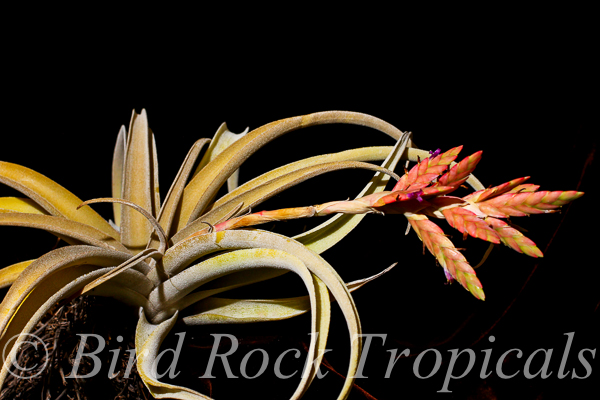
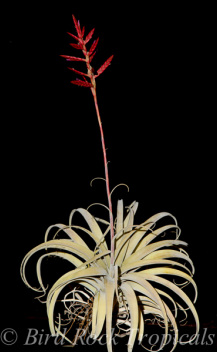
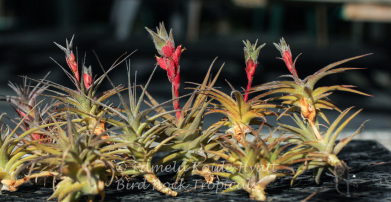
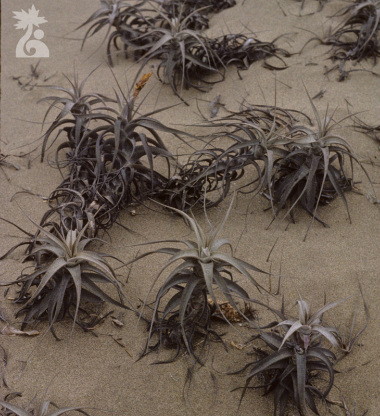

 RSS Feed
RSS Feed